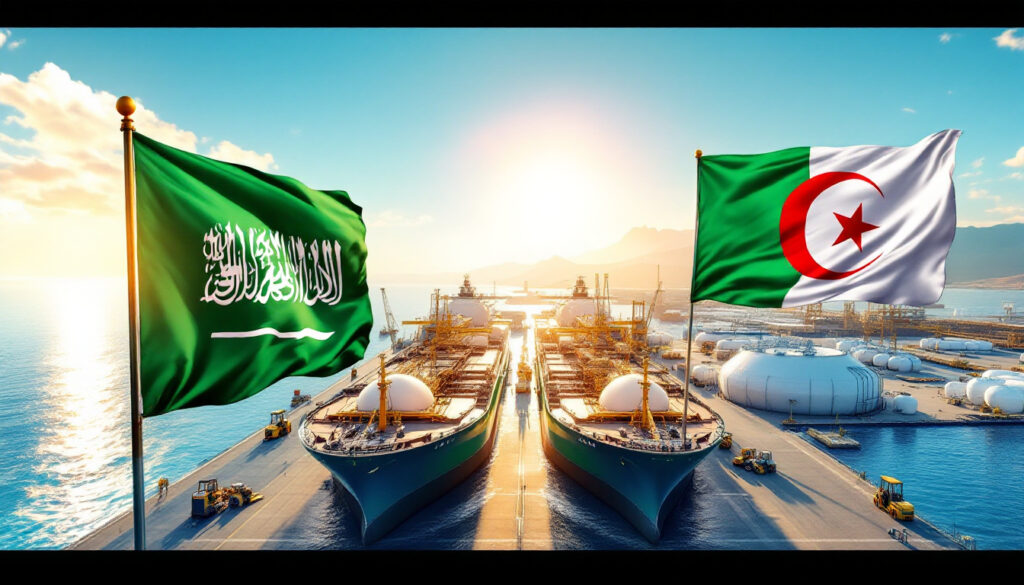What Are LPG Official Selling Prices (OSPs)?
Official Selling Prices (OSPs) serve as critical benchmark prices in the global liquefied petroleum gas (LPG) market, established monthly by major producers to guide international trade. These reference prices significantly impact contract negotiations and spot market dynamics across different regions worldwide. In the LPG industry, Saudi Aramco and Sonatrach stand as two of the most influential price setters, with their monthly announcements closely monitored by traders, buyers, and market analysts.
Saudi Aramco's pricing decisions primarily influence the Asia-Pacific region, while Sonatrach's OSPs serve as benchmarks for Mediterranean, Black Sea, and Turkish markets. The monthly price adjustments typically reflect a complex interplay of factors including regional demand patterns, inventory levels, seasonal considerations, and broader energy market trends.
For April 2025, Saudi Aramco maintained its propane OSP at $615 per metric ton and butane at $605 per metric ton, indicating market stability in Asian markets. In contrast, Sonatrach reduced its propane price by $10 to $550 per metric ton (a 2% reduction) and cut its butane price by $40 to $545 per metric ton (a 7% reduction), signaling different market conditions in the Mediterranean region.
These price differentials between regions—with a notable $65 per metric ton gap between Aramco and Sonatrach propane prices—create arbitrage opportunities for international traders when the spread exceeds transportation costs. Industry experts note that such regional divergences often reflect localized demand-supply balances rather than global commodity market insights.
Saudi Aramco's April 2025 LPG Pricing Strategy
Maintaining Price Stability
Saudi Aramco's decision to hold its April 2025 Official Selling Prices steady marks the second consecutive month of unchanged pricing, suggesting a strategic approach to market stability. By maintaining propane at $615 per metric ton and butane at $605 per metric ton, Aramco signals confidence in balanced supply-demand dynamics across its primary Asian markets.
This price stability comes amid relatively consistent demand from key customers in China, Japan, South Korea, and India. Market analysts note that stable pricing demonstrates Aramco's commitment to predictable supply relationships with Asian buyers, particularly as petrochemical demand remains resilient in the region despite global economic uncertainties.
"The unchanged OSPs reflect Aramco's strategic balancing act between maintaining market share and optimizing revenue," notes a senior LPG trader with a major Asian importer. "This pricing approach provides downstream buyers with the predictability needed for their operational planning."
Regional Significance of Aramco's Pricing
Aramco's price decisions carry outsized importance in the Asia-Pacific region, where most term contracts are directly linked to Saudi OSPs. As the region's benchmark price setter, Aramco's monthly announcements often trigger ripple effects throughout the entire supply chain, influencing everything from petrochemical feedstock costs to residential LPG prices.
Asian refiners and petrochemical producers typically use Aramco's OSPs as direct inputs in their operational budgeting and margin calculations. For Japan and South Korea, where winter heating demand creates seasonal consumption patterns, the stable pricing provides welcome predictability for inventory management.
The consistent pricing strategy also aligns with Saudi Arabia's broader goal of protecting market share in Asia against competitors from the United States, Qatar, and the United Arab Emirates. By avoiding price increases that might incentivize buyers to seek alternative suppliers, Aramco maintains its position as the preferred supplier for many Asian term contracts.
Sonatrach's April 2025 LPG Pricing Adjustments
Price Reduction Strategy
In contrast to Aramco's stability-focused approach, Algeria's state energy company Sonatrach implemented significant price reductions for April 2025. The company cut its propane OSP by $10 to $550 per metric ton, representing a 2% reduction from March levels. More dramatically, Sonatrach reduced its butane OSP by $40 to $545 per metric ton, a substantial 7% decrease compared to the previous month.
These price cuts reflect Sonatrach's responsive approach to changing market conditions in its primary export regions. Industry analysts point to softening demand across Mediterranean markets, particularly in Southern Europe, as the driving factor behind these reductions. The steeper cut for butane specifically addresses oversupply concerns in automotive and industrial applications across the region.
"Sonatrach's pricing strategy demonstrates a willingness to adjust quickly to market realities," explains a Mediterranean LPG distributor. "The significant butane reduction particularly aims to stimulate industrial consumption in a traditionally slower spring season."
Regional Impact of Sonatrach's Pricing
Sonatrach's price adjustments hold particular significance for Mediterranean and Black Sea markets, where the Algerian company's OSPs serve as primary benchmarks. Turkey, as one of the largest importers in the region, stands to benefit significantly from these reduced prices, with the LPG cuts potentially lowering input costs for its substantial residential and automotive LPG markets.
The $65 per metric ton price differential between Aramco's and Sonatrach's propane prices creates notable arbitrage opportunities for traders with logistics capabilities between the Mediterranean and Asia. When regional price gaps exceed transportation costs, cargo redirection becomes economically viable, helping balance global markets.
Spanish, Italian, and Greek markets typically use Sonatrach's announcements as reference points for their own domestic pricing mechanisms. The company's decision to implement substantial cuts signals competitive pressures within the Mediterranean basin, potentially from increased exports from Eastern Mediterranean producers and U.S. exporters targeting European markets.
How Do LPG Price Benchmarks Affect Global Markets?
Regional Benchmark Significance
The divergence between Saudi Aramco's stable pricing and Sonatrach's reductions illustrates the regionalized nature of global LPG markets. While physically identical, propane and butane values can vary significantly across geographic markets due to localized supply-demand balances, transportation constraints, and different seasonal consumption patterns.
In Asia, Aramco's OSPs directly influence term contract prices for major buyers in China, Japan, South Korea, and India. These prices also serve as reference points for spot cargo negotiations throughout the region, with most transactions priced at a premium or discount to the Saudi benchmark. The stability in Aramco's April pricing suggests balanced market conditions across Asian demand centers.
Meanwhile, Sonatrach's benchmarks primarily affect Mediterranean, Southern European, and Turkish markets. The significant reductions in April pricing indicate softer demand conditions across these regions, likely due to seasonal transitions and industrial consumption patterns. The Turkish market, which relies heavily on LPG for both residential and automotive applications, stands particularly influenced by Sonatrach's decisions.
The $65 per metric ton price differential between Asian and Mediterranean propane creates incentives for cargo diversion when the spread exceeds freight costs. This arbitrage mechanism helps balance global markets by redirecting supply from lower-priced to higher-priced regions, though shipping constraints and canal transit times can limit the effectiveness of this rebalancing.
Market Indicators and Trends
Price divergences between regional benchmarks serve as important indicators of underlying market conditions. Aramco's price stability suggests steady Asian demand, supported by consistent petrochemical sector consumption and residential usage. The significant price premium in Asian markets compared to Mediterranean prices reflects stronger fundamental demand and possibly tighter regional supply balances.
Conversely, Sonatrach's price cuts signal challenges in Mediterranean markets, potentially including softer industrial demand, higher regional inventories, or increased competition from alternative suppliers. The steeper reduction for butane compared to propane indicates particular weakness in butane-specific applications like automotive fuel and industrial processes.
These regional pricing differences create trading opportunities beyond simple cargo diversion. Sophisticated market participants can leverage these differentials through paper trading, time spreads, and product swaps between propane and butane based on their relative values in different regions.
"The price divergence between Aramco and Sonatrach benchmarks creates a $65 per ton arbitrage opportunity for traders who can manage the logistics between regions," notes a senior LPG broker. "When these regional imbalances persist, they often trigger cargo reroutings that eventually help normalize global pricing."
Understanding LPG Market Fundamentals
Types and Applications of LPG
The LPG market revolves around two primary hydrocarbon gases: propane (C₃H₈) and butane (C₄H₁₀), each with distinct properties and applications that influence their respective demand patterns and price dynamics. Propane, with its lower boiling point of -42°C, remains gaseous at higher temperatures than butane (-0.5°C), making it more suitable for winter heating applications in colder climates.
Butane, with its higher energy density, finds widespread use in portable applications like cigarette lighters and camping stoves. In warmer regions, butane serves as a preferred automotive fuel component due to its favorable combustion properties. The different seasonal demand patterns for these products often create pricing spreads that vary throughout the year.
Beyond heating and transportation, both gases serve as vital petrochemical feedstocks. Propane dehydrogenation (PDH) units convert propane into propylene for plastics production, while butane contributes to synthetic rubber manufacturing. These industrial applications typically provide more stable year-round demand compared to the highly seasonal residential consumption patterns.
"The petrochemical sector consumes approximately 35% of global LPG production," according to industry estimates. "This industrial demand provides a baseline consumption pattern that helps stabilize markets outside of heating seasons."
Supply-Demand Dynamics
Middle Eastern producers, with Saudi Aramco at the forefront, supply approximately 35% of global LPG exports, leveraging their associated gas production from massive crude oil operations. North African producers, led by Sonatrach, primarily serve Mediterranean markets with exports from Algeria's substantial natural gas processing facilities.
Demand patterns vary significantly by region and season. Asian markets show strong petrochemical demand year-round, supplemented by winter heating needs in Japan, South Korea, and northern China. Mediterranean markets demonstrate more pronounced seasonality, with summer peaks for automotive use and winter spikes for residential heating.
The industrial demand for LPG tends to follow broader economic cycles rather than seasonal patterns, providing a more stable consumption base. Petrochemical facilities typically maintain consistent operations regardless of season, adjusting feedstock slates between propane, butane, and heavier alternatives like naphtha based on relative economics.
This complex interplay of supply sources and demand patterns creates the regional price differentials reflected in the April 2025 OSP announcements. Aramco's price stability indicates balanced fundamentals in Asia, while Sonatrach's reductions suggest temporary oversupply conditions in Mediterranean markets. Recent China's new methane regulations could further influence regional gas markets as countries adapt to changing emissions standards.
Investment Implications of LPG Pricing Trends
What Pricing Signals Mean for Investors
The divergent pricing strategies between Saudi Aramco and Sonatrach provide valuable signals for energy sector investors. Aramco's decision to maintain stable pricing for a second consecutive month suggests confidence in Asian demand fundamentals, supporting a positive outlook for midstream operators and distributors serving these markets.
Conversely, Sonatrach's significant price reductions, particularly the 7% cut for butane, signal potential challenges in Mediterranean markets that investors should monitor. Companies heavily exposed to Southern European or Turkish LPG distribution may face margin pressures if these price cuts reflect genuine demand weakness rather than strategic market share considerations.
The $65 per metric ton price differential between Asian and Mediterranean markets creates opportunities for trading houses and logistics companies that can capitalize on arbitrage movements. Investors in shipping and storage infrastructure may see increased utilization as cargoes reposition to capture these regional differentials.
For downstream petrochemical producers, the price signals have mixed implications. Asian petrochemical companies face stable feedstock costs, providing operational predictability but limited opportunity for margin expansion through lower input costs. Mediterranean petrochemical producers, however, may benefit from Sonatrach's reduced pricing, potentially improving their competitive position against Asian manufacturers.
Market Outlook Considerations
Looking ahead, several factors may influence the LPG pricing landscape through mid-2025. Seasonal transitions will play a crucial role, with Northern Hemisphere summer approaching and its typical reduction in heating demand potentially putting downward pressure on propane values, particularly in Mediterranean markets.
Supply chain logistics remain a wild card factor, with persistent Red Sea shipping disruptions potentially maintaining artificial price differentials between regions by increasing the effective cost of arbitrage. Vessels needing to route around Africa face significantly longer transit times and higher costs, potentially sustaining wider-than-normal regional price spreads.
Geopolitical factors, including potential production disruptions in key exporting regions, present another variable that investors must monitor. Any supply interruptions from major producers could quickly reverse the current soft pricing in Mediterranean markets or challenge the stability seen in Asian benchmarks. The ongoing effects of geopolitical policies reshaping commodity markets will likely continue to influence Saudi Aramco and Sonatrach LPG prices throughout 2025.
"Regional price differentials are likely to persist through Q2 2025, with potential narrowing as seasonal demand patterns shift and arbitrage movements rebalance markets," suggests a leading energy market analyst. "Investors should closely monitor Aramco and Sonatrach's May and June pricing announcements for signals of changing market dynamics."
The evolving focus on decarbonisation in mining and the clean energy transition may also indirectly impact LPG markets as industries reassess their energy sources and feedstock choices in the coming years.
FAQ: Saudi Aramco and Sonatrach LPG Pricing
How often do Saudi Aramco and Sonatrach adjust their LPG prices?
Both Saudi Aramco and Sonatrach typically announce their Official Selling Prices (OSPs) on a monthly basis. These announcements usually occur during the last week of the preceding month, giving buyers and traders time to adjust their strategies for the upcoming period. The monthly adjustment frequency allows producers to respond to changing market conditions while providing enough stability for term contract negotiations.
The assessment process incorporates multiple factors including regional demand trends, global inventory levels, competing fuel prices, and broader energy market developments. Both companies employ sophisticated market intelligence to inform their pricing decisions, balancing revenue optimization with market share considerations.
While monthly adjustments are standard, exceptional market conditions occasionally prompt mid-month revisions. However, such unscheduled changes are rare and typically reserved for extraordinary circumstances like major supply disruptions or dramatic demand shifts.
What is the difference between propane and butane pricing?
Propane and butane prices frequently diverge due to their distinct chemical properties and end-use applications. Propane's lower boiling point makes it essential for winter heating in colder regions, creating stronger seasonal demand patterns that typically push prices higher during winter months in the Northern Hemisphere.
Butane, with its higher energy density but higher boiling point, finds favor in warmer climates and automobile fuel applications. Its pricing often strengthens during summer months when gasoline blending demand increases, particularly in regions with seasonal gasoline formulation requirements.
In April 2025, Saudi Aramco maintained a $10 per metric ton premium for propane ($615) over butane ($605), reflecting the typical value relationship in Asian markets. Interestingly, Sonatrach's pricing showed only a $5 spread but in the opposite direction, with butane ($545) priced lower than propane ($550)—indicating different regional value perceptions between these products.
The varying price spreads between propane and butane across regions create additional trading opportunities beyond simple geographic arbitrage. Sophisticated market participants often develop strategies around these product value differentials, adjusting their product mix based on regional spread dynamics.
How do these benchmark prices affect global LPG markets?
Aramco and Sonatrach's benchmark prices permeate throughout the global LPG market through multiple mechanisms. Most directly, they serve as reference points for term contract negotiations, with many buyers accepting formula pricing based on the published OSPs plus or minus a negotiated premium or discount.
These benchmarks also heavily influence spot market transactions, providing reference points from which traders negotiate spot cargo values. Even in markets not directly served by either company, their pricing decisions provide important signals about global supply-demand balances that influence local pricing discussions.
The April 2025 price announcements demonstrate how these benchmarks reflect and reinforce regional market conditions. Aramco's stable pricing suggests balanced fundamentals in Asia, while Sonatrach's reductions indicate softer demand in Mediterranean markets. The significant $65 per ton differential between these regions highlights the regionalized nature of LPG markets despite the global commodity status of the products.
For market participants, understanding the relationship between these benchmark prices and local market dynamics is essential for effective risk management, procurement strategies, and investment decisions in LPG-related infrastructure and businesses. These dynamics are further influenced by the commodity super-cycle reshaping global supply chains and investment decisions across energy markets.
Ready to Stay Ahead in the LPG Market?
Discover real-time alerts on game-changing commodity market developments with Discovery Alert's proprietary Discovery IQ model, providing immediate insights into high-potential ASX opportunities across the energy sector. Visit Discovery Alert's discoveries page to understand how significant market movements can generate substantial returns for prepared investors.




